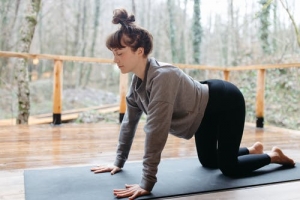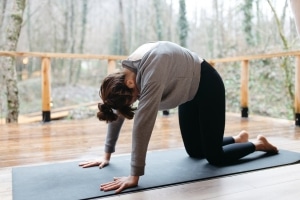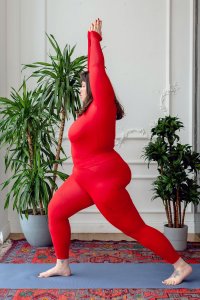The benefits of yoga for your body, mind, and all around emotional and physical wellbeing seem to have no end. Research has shown that practicing yoga in menopause can help prevent memory loss and aid brain function , can help reduce cellular aging , can boost your metabolic rate , and can generally help keep up emotional wellbeing . This array of general benefits aside, yoga has also been linked to improving specifically menopausal symptoms like hot flashes , joint aches and low mood and anxiety and led yoga to being recognized as one of the best exercises for menopause .
Studies have shown it helps to reduce osteoporosis and bone density loss , a common problem among menopausal women, can mediate hot flashes, reduce menopause-related insomnia , as well as helping to prevent anxiety and depression .
Time and time again, yoga has been linked to a reduction of menopause symptoms and a serious improvement in the quality of life of perimenopausal and menopausal women. You might be raring to go, unfurl your yoga mat and get stuck into some of its significant benefits – but the problem is, where do you start? If you’re struggling to find a local yoga class to attend, or if you’re not comfortable doing some of the more complex poses out of the comfort of your own home (who doesn’t feel a bit silly doing downward dog!), starting yoga can feel a bit like trying to walk through the woods without a map. The poses are new, the breathing can be tricky to figure out – and all in all, you might be feeling a bit discouraged about getting stuck in.
However, have no fear! In the age of the internet, YouTube has become an incredible platform for yoga professionals of all methods, aims, and practices to create helpful, easy to use tutorials to help you start your Yoga journey. The only hurdle is that there can be too many options to know where to begin your menopause yoga training.
Here are our suggestions on where to find yoga instructors to help with your symptoms and your needs. We’ll give you some basic yoga terms, highlight three of the best poses to ease menopause symptoms, and include the low-down of the best yoga youtubers for menopause – everything you need to know to begin your menopause yoga journey!
Basic yoga terms
When you dip your toes into the world of online yoga, the first barrier can be the lingo. Many yoga teachers can rely on the traditional Sanskrit names for poses and movement, which can end up leaving you a bit confused, interrupting your flow by forcing you to stop and look up the meanings of the individual words. Take a look below for some of the more commonly used yoga terms to give you a good jumping off-platform for when you next pull on your yoga pants.
Vinyasa
Vinyasa is the practice of movement between poses in yoga – characterised as a flow between one pose to the next in a constant stream of movement.
Hatha
A different practice of yoga from vinyasa, Hatha yoga involves moving into then holding a pose for longer periods of time, with the aim being more slow-paced.
Drishti Point
A Drishti point can be a savior – especially if you’re more balance-challenged! Working like a focal point, when an instructor encourages you to pick a Drishti point you should pick one point in the room to stare at in order to help maintain your balance.
Savasana
Also known as the corpse pose, savasana is the restorative position often used at the end of yoga classes to help counteract the energy of the movements. Savasana is achieved by lying flat on your back, with your legs and arms slightly apart, your palms facing up. It is said to help you achieve calm and peace – always a helpful thing with menopause!
Namaste
Often the word used to end a yoga session, namaste is a symbol of respect and recognition between you and the yoga teacher.
Best poses for menopause
Though all yoga is good for menopause, some poses can be especially helpful in treating certain symptoms. These poses can be great in helping easing lower back ache, opening up your breath and getting you moving, or simply good for the soul.
Downward facing dog
The most famous (or infamous) of yoga poses, downward facing dog can actually be a wonder for helping increase joint flexibility, easing any creaky backs and helping prevent osteoporosis. Get onto all fours, with your wrists below your shoulders and your knees directly underneath your hips. Slowly lift your knees off the floor and send your hips back, while straightening your arms. Lower your gaze to the floor, and try to bring your heels as close to the floor as you can – the more your practice, the easier this will become.
Cat/cow
A brilliantly restorative pose, even just doing cat cow once every day for a few minutes can do wonders for any joint aches, and can help to improve your mood. Like downward facing dog, start on all fours with your wrists directly beneath your shoulders, and your knees bent beneath your hips, around hip-width apart. Inhale, and draw your chest and your head up till your gaze is above you, lending to a generous curve in your spin. On an exhale drop the head and lower your chest, bringing your back up to a rounded curve. Move between the two positions at whatever pace works for you.
Warrior 1
Warrior one involves both a lot of breath work, which helps to lower feelings of uneasiness and help reduce hot flashes, as well as helping your muscles get a deep stretch which eases joint aches and leaves you loose and sleepy – all the better to fight off sleep related problems. An easy way to get into warrior one is to start in downward dog. Step your right foot forward up to the inside of your right hand. Turn the ball of your left foot out to the left and drop your heel to the floor. Bend your right knee, making sure to keep your right thigh directly parallel to the floor. Rise to standing, lifting your arms straight up and over your head toward the sky – you can touch your palms together, or keep them far apart – whatever feels better.
Best yoga YouTubers for menopause
We’ve compiled some of the best yoga videos for menopause that we could find, freely available on YouTube.
YOGA WITH ADRIENE – best all-rounder
Day 1 – Ease Into It – 30 Days of Yoga – YouTube
If you’re new to the practice of yoga and feeling a bit unsure, or just want a teacher who can offer you cure-all instructions for every ailment under the sun – from back aches, to tension headaches, to brightening up a gloomy mood – Adriene is a great place to start. With an infectious enthusiasm, and a simple, down-to-earth approach to teaching yoga, Adriene’s courses focus on explaining positions, providing thorough workouts without being intimidating or exhausting, and making you feel a bit more at home in your body. A recommended starting point, especially for beginners, is her 30-day yoga challenge – with gradually increasing difficulty, you can really see your body start to strengthen as it gets used to the position, and the different videos gives you a taste-tester of exercises to help your specific symptoms and needs. If you’re currently experiencing perimenopause, check out her Yoga for Women video, which can help you transition through painful and erratic cycles.
Try also yoga for hot flashes .
BRETT LARKIN – best for brain fog
https://www.youtube.com/watch?v=qUh3daQwVWc
Brett Larkin’s cool, confident voice and her measured rhythmic practices are great for developing some of your yoga skills – from muscle strengthening to balance – but she really excels at using yoga to improve your mental state and emotions. Using guided meditation and breathing, Larkin has a number of videos designed to help improve memory, cut through the haze of brain fog, and have you feeling the best you can possibly be mentally. She also has a great set of exercises specifically designed to help women who are struggling with perimenopause – both to help the physical symptoms, but also to aid in breaking down the mental barriers that often accompany it.
KINO YOGA – best for development
One Hour Yoga Class — Balanced Harmonious Flow with Kino – YouTube
If you’re not new to the yoga practice, but specifically want to help deepen your skills and help train your joints, core, and the muscles that are most struggling with menopause, Kino Yoga’s hour-long classes help challenge you and bring out new methods, emotions, and successes. She also has a selection of brilliant beginner’s courses, but with her longer practices can really help develop and tone the areas that are giving you the most grief – uplifting you where you need it most, whether that’s bad ankles, a sore back, or cramps. She also has a brilliant video that is great if you’re struggling with menopause-induced insomnia.
YOGATX – best for joint pain
Yoga For Back Pain – 30 Minute Back Stretch, Sciatica Pain, & Flexibility Yoga Flow – YouTube
If it’s the pesky joint aches that accompany menopause that have led you to yoga, look no further. YOGATX has a vast array of videos curated specifically to help the parts of your body that are most feeling the strain of peri and menopause. Her focus on opening up joints and bringing blood flow to neglected areas – such as the lower back, the hips, and the neck – not only make you feel great but help target places vulnerable to osteoporosis and strengthen your pelvic and urogenital areas.
Try also Yoga specific to menopause joint pain .
SADIE NARDINI – best for busy lives
Faster Flexibility: Legs, Hamstrings, & Hips Yoga Stretch – YouTube
If you want to feel stronger and uplifted but are struggling to fit in a forty minute yoga flow exercise, Sadie Nardini is who you want. With her series of quick videos for yogis-on-the-go, such as the above two minute stretching sequence, Sadie shows you how to get the best benefits out of yoga on a reduced timescale. Her brisk instructional videos focus on joint-openers, flexibility-improvers, and strength-builders, all poses that can be incorporated into your daily life and can help alleviate some of your symptoms. She also has a series of fifteen-minute high-intensity yoga sessions if you’re looking for a bit of a hotter burn.
JESSAMYN STANLEY – best for confidence
Jessamyn Stanley’s 8-Minute Yoga for Self-Love | Health – YouTube
A yogi who has been making waves for self-love and self-esteem, if you’re feeling a bit down or unhappy with your body, Jessamyn is the person to have you on your way to feeling strong, confident, and proud of who you are. Her poses give you a good stretch, but her narration also helps you to see what the yoga is doing for you, and the strength of your body in helping you to achieve difficult and complex shapes. Menopause can make you feel at sea and without self-esteem – Jessamyn uses yoga, humor, and joy to build it back up again.
COLE CHANCE – best for mood
Yoga for Anxiety and Stress with Echo – YouTube
If you’ve been struggling with mood issues or feeling a bit hopeless, Cole Chance’s soothing narration and her slow, gentle practices use meditation and breathing to help balance mood and help you feel a bit better and brighter. With a background dealing with therapy and addiction, Chance uses yoga as a therapeutic tool to guide her practitioners through some of the darker moments – a boon if you’re finding it tough at the minute.
Try also yoga for stress and anxiety relief .
YOGA WITH KASSANDRA – Best for fatigue
30 min Yin Yoga for Hormones – Yoga for Adrenal Fatigue & Thyroid Issues – YouTube
Menopause can often leave you feeling weak and low-energy. Kassandra’s yoga for hormonal issues and tiredness focuses on using breathing techniques, and gentle but deep-stretch poses to inject a burst of movement and energy into your day, and hopefully help you feel a bit more alert and awake.
The information and advice provided on our website including expert advice, articles and resources, are not intended as a substitute for the advice provided by your own doctor or other health care provider.





